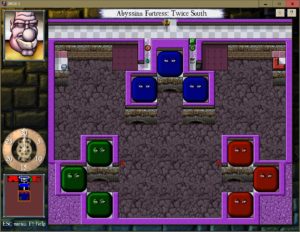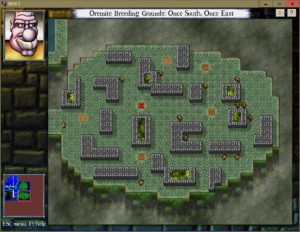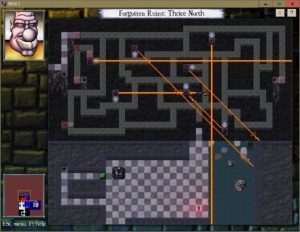TCB: The Undercity
Finishing The City Beneath means being repeatedly told “Oh, you thought you were done, did you?” When you reach the end, there’s still the secret rooms. When you’ve beaten all of those, it opens up the Master area, The Undercity, which has its own suite of twelve puzzles. The previous episodes also had their own playable bits in the epilogue, but not in quite the same way — in King Dugan’s Dungeon, it was just some repeats of rooms you had already solved, as Beethro describes them to his nephews, while in Journey to Rooted Hold, it was a display of some rejected rooms that you could try if you wanted to. In TCB, it’s more rejected rooms, mostly variants on things that were in the game but got changed because they were too hard. But they’re presented as a level, something you’re really expected to solve. The UI pointedly keeps track of how many you’ve cleared, in a way that it doesn’t even do in the main part of the game. Doing them all gives you one final Challenge/Achievement.
Or perhaps not final! I still had one more Challenge to go back and find in the regular game — one of those unscrolled ones, designating an optional cutscene. I actually though for a while I had more than one of those, because Steam had Achievements described as “(TCB) TU: Clear all 12 puzzle rooms (then visit 1W)” and “(TCB) TU:3N – Win a game of ‘Mastermind’ on the first visit to the room”. This was confusing because “TU” is ambiguous: in addition to “The Undercity”, it’s short for “The Uncturage”, one of the earlier levels, which doesn’t even have rooms at 1W or 3N.
One of the Master puzzles is an earlier and less-complicated version on the baffling puzzle I described previously. This was rejected for being too hard, presumably because you have to clear the gel personally and single-handedly, but I honestly found it easier than what wound up in the main dungeon. Another is a version of the five-Slayers-at-once room, but without the decoy potion that lets you just blow everyone up. Instead, it has a whole bunch of bombs and internal walls scattered around, to create more situations where you can exploit Slayer AI. This was rejected when the designers realized that they hadn’t ever taught the player how to kill Slayers. The techniques were well-known on the DROD forums, and reasonable fodder for Challenges, but not for a crit-path puzzle. Indeed, this is the only puzzle that’s considered to be too hard even for the Undercity, and isn’t included in the twelve you’re expected to solve. I personally had of course already done the canon version of the room the hard way for the sake of the Challenge, but I found the Undercity version difficult, not just despite the extra bombs, but because of them. I really know only a few tricks for killing Slayers, and the most versatile one — the one I used in JtRH L7:1E — requires an amount of empty space that’s hard to come by with all those bombs around.
At any rate, that’s basically it for my second tour of The City Beneath, and if I didn’t have as much to say about it as I did the first time, maybe that’s just a sign that I shouldn’t blog games twice. I’ll be going on to Gunthro and the Epic Blunder soon, which shouldn’t take long to complete. I recall finishing it in a single weekend the first time.
 Comments(1)
Comments(1)

